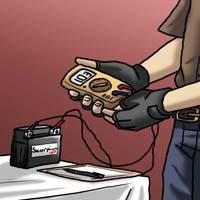How Does the Powersports Battery Warranty Work?
Our Scorpion and Motocross (Yuasa) AGM and Wet Cell batteries come with a 1 year replacement warranty against manufacturer defects. The Scorpion Lithium brand has a 1 year replacement warranty against manufacturer defects when used in prescribed applications listed on their product pages (custom applications will void the battery warranty). In rare cases, such as multiple failures, all warranty obligations may be fulfilled by BatteryStuff.com issuing a pro-rated store credit based on the number of months remaining in warranty from the original date of purchase. Cash Refunds will not be given, and Store Credits will only be issued at the discretion of BatteryStuff.com and is not considered a 'normal' function of warranty.
In cases where a battery is out of stock and the customer qualifies for a replacement battery, we are allowing the customer to wait for their replacement battery. If the customer would rather not wait, we are allowing customers to have their warranty prorated towards store credit if the battery is out of stock.
Batteries less than 30 days old will be replaced at no charge. For batteries over 30 days, the customer must pay for the shipping of the new replacement battery, which is typically $13.00 - $25.00 within the USA. For Canada the customer must pay the current UPS/FedEx Ground Rate, and the replacement is still subject to brokerage fees and taxes, which is the responsibility of the customer.
In efforts to save customers the expense of shipping the battery back for testing, we do allow our customers to perform a simple test to be conducted at the customer’s location. However, if the customer does not have the required equipment (Voltmeter and Battery Charger), or is unwilling to perform the test, or test results are deemed inconclusive then the customer must ship the battery back at their expense. If the customer chooses to ship the battery back for testing they must first receive a Return Authorization Number. All shipments received without a Return Authorization Number may be refused. If a returned battery shows signs of physical damage, misuse, or overcharging the warranty will be void.
The following test may be required in order to proceed with any warranty claims:
One of the facts of life is that batteries fail. Some take years, but eventually they will all bite the dust. However, there are so many factors in electrical systems that can go wrong, that often times the battery takes the blame for other component's problems. The easiest and fastest thing to check for problems is the battery. Here is a simple test that can tell you a lot about what is going on inside a battery, and whether it is good or not. This is not meant to test anything other than the battery, but it is a great place to start if you are having electrical problems.
The first thing to do is to get a pen, a notebook, a voltmeter, and a charger. For this test we will assume that the batteries in question are 12v.
Step #1: Disconnect the battery from the system, remove cables and connectors, and clean off the terminals. Take a voltage reading for reference and make sure to write it down.
Step #2: Try to charge the battery with the 12 volt charger. Hook it up to the charger and let it charge for a full cycle.
Note: If you are using a smart or automatic charger and your Step # 1 voltage reading is below about 6.5 volts, then you will need to hook up the battery in parallel with another battery in order to charge it. You can do this with any other 12 volt battery, including a car battery, using jumper cables, but DO NOT start the engine of the car if you are using one. You don't need the charger to complete its full cycle hooked up to the battery in testing, just give it enough time to add some voltage, usually 10-20 minutes. Then disconnect the second battery, and let the charger charge the battery in question.
Step #3: After the charger indicates that the battery is fully charged, or if it has charged for more than 8 hours, disconnect the charger from the battery. Let it sit for 30 minutes and then take another voltage reading.
Step #4: Let the battery sit for 12 hours with no load, DO NOT load test at this time. After the 12 hours take another volt reading. You should be recording the results of each of these readings as you go.
Step #5: Hook the battery back up to the bike, or RV, or whatever you took it out of. If you are testing a starting battery, hold the volt meter on the battery while you attempt to start the motor. Record what the voltage drops to. If you are testing a RV battery, turn on as many electrical devices as you can while the voltmeter is on the battery.
After you have gathered all of this data, email us the results at returns@batterystuff.com. Include in the email:
- Description of symptoms
- All 4 voltage readings labeled at what stage they were recorded
- Your return Contact information
- Order information if it is a battery that you bought from us.
The following is a video demonstration of this procedure.
Our technical department will analyze the data within 1-2 business days and respond to you with a conclusion. If the information is conclusive, they will be able to tell you what the problem is, and how best to proceed.



